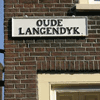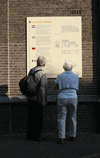In February 29, 1676, the assistant clerk of the Delft notary public J. van Veen drew up the inventory of all movable goods in the house owned by Maria Thins Vermeer's mother-in-law, on Oude Langendijk Delft, corner Molenpoort. Here, Maria Thins, Vermeer, and his family had resided for some years and it was also here that the painter almost certainly kept his studio. Vermeer had died a few months before on December 13 or 14, 1675. The original inventory document is conserved in the Delft Municipal archives (Gemeentearchief Delft, records of J. van Veen, no. 2224).
"The estate inventory is divided in two sections. In the first section the notary’s clerk recorded on face-to-face pages the effects in the house on the Oude Langendijk that belonged to Catharina Bolnes, Vermeer's wife. These included the items that Vermeer had owned until his death. The second section records the ‘Specification of all household goods and effects, half of which each belonging to Juffrouw [Miss] Maria Thins, widow of the late Sinjeur [Mr] Reijnier Bolnes, and to her daughter Juffrouw Catharina Bolnes, widow of Johannes Vermeer, and housed in the residence of the aforementioned widow located on the Oude Langendijk here on the corner of the Molenpoort.' This category covers the effects for which Catharina shared ownership with her mother Maria, primarily large pieces of furniture, such as cupboards, tables and chairs, paintings and some smaller household goods."PieterRoelofs, "Closer to Vermeer," in VERMEER, ed. Pieter Roelofs & Gregor Weber, Rijksmuseum, Amsterdam, 2023, 50.
The document has long intrigued historians, prompting queries about the house's layout, the family's daily life, and the environment in which Vermeer created his renowned paintings.Pieter Roelofs, Closer to Vermeer: A Look Inside the Family Home of the Delftin VERMEER, ed. Pieter Roelofs & Gregor Weber, Rijksmuseum, Amsterdam, 2023, 42-45.But, despite the efforts of specialists and historians, the items listed in their original setting have been examined only individually, with their significance in terms of spatial placement and interrelation largely overlooked. However, Pieter Roelofs, the current Head of the Department of Fine Arts at the Rijksmuseum, has undertaken a comprehensive analysis. His research offers fresh insights not just into the objects in the inventory but also into the personal, family and artistic life of Vermeer (Roelofs & Weber, VERMEER, Rijksmuseum, 2023, 42-99).Pieter Roelofs, "Closer to Vermeer: A Look Inside the Family Home of the Delftin VERMEER, ed. Pieter Roelofs & Gregor Weber, Rijksmuseum, Amsterdam, 2023, 42-99.
Vermeer's principal biographer, John Michael Montias, believed that the inventory of Catharina's possessions "did not cover all of her movable goods. Some of her best things had been put away. Either that or the notary's clerk had been told that they belonged outright to Maria Thins and were not part of the goods that the mother and daughter owned in common. Vermeer's masterpiece, Art of Painting had been formally transferred from daughter to mother, but some other, less valuable items may have gone the same route without benefit of notarial supervision. This subterfuge may have been intended with an eye on the petition for 'letter of cession' on her debts that she would soon submit to the magistrates."John Michael Montias, Vermeer and His Milieu: A Web of Social History (Princeton, NJ: Princeton University Press, 1989), 222. Recent research by Hans Slager and Pieter Roelofs suggestsand alternative reading, summarized in the three paragraphs elow.PieterRoelofs, "Closer to Vermeer," in VERMEER, ed. Pieter Roelofs & Gregor Weber, Rijksmuseum, Amsterdam, 2023, 50.
Through various historical documents such as burial registers, notarial deeds, and estate inventories, the text pieces together where the Vermeer-Bolnes family and Maria Thins resided over the years. These documents indicate that they lived on the Oude Langendijk in Delft. The narrative suggests that Maria might have initially rented the Trapmolen house, allowing Johannes Vermeer to move in around 1653 when he married Catharina. Later, possibly post-1663, Maria might have moved to another house named Fonteijn. However, evidence shows that she was still living on the Oude Langendijk as late as February 1667.
In the later years of her life, Thins sold the Fonteijn house in 1679 and went on to live with her relatives, the Van Rosendael sisters, in the Begijnhof, a significant center in the Catholic community. In January 1680, while making her will, she listed her residence as being with the Van Rosendael sisters.
Maria Thins passed away around the end of 1680. At the time of her death, she was brought from the Van Rosendael residence to her daughter Catharina's home, where she eventually died. Her burial was recorded meticulously; she was carried from the house on the Oude Langendijk, likely the Trapmolen house, to her final resting place, escorted by fourteen pallbearers.
Vermeer's Home
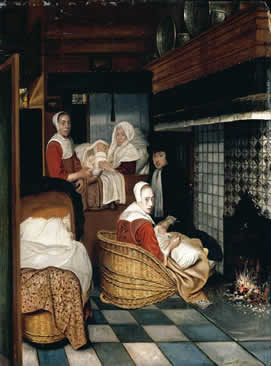
Cornelis de Man
1670s
52 x 45 cm.
Private collection
Vermeer, his family lived at Oude Langendijk from about 1660 to Vermeer's death in 1675. The contents of the house was not what would be termed luxurious. Some objects were worn and of little value. Instead, the wardrobe of the Vermeer family was more than adequate although lacking if compared to the wardrobes of the rich Delft burgers. Several jackets or coats belonged to Vermeer and a few fur-lined jackets (the type which we see in Vermeer's compositions) were owned by Catharina. In the seventeenth century, clothes were extremely expensive, and the poor had scarcely one of each basic type of garment at best. Hats, gloves, nightwear, and silk in Vermeer's house were lacking. Most scholars assume that the back room of the top floor was Vermeer's studio because various pieces of painter's equipment are listed. Vermeer's studio faced north, the preferred exposure for artists' studios.
Even a cursory glance at the items listed in the inventory below will suggest that the interiors of Vermeer's paintings seem to be very different from what we would imagine. Few of the luxury objects, such as carpets, marble flooring, silver trays and musical instruments—all which appear in the same room in some of Vermeer's paintings—were seldom found in any but the wealthiest homes and do not appear in the inventory in question. Oppositely, none of the common household objects such as cradles, beds, and shabby furniture found all over the house ever upset Vermeer's perfect compositions.
In general, the density of furnishings in Dutch homes was much higher than what appears in Dutch interior painting (see, for example, the image above of a Delft interior by the local Delft painter Cornelis de Man). Vermeer's ordered spaces were deliberately set up and carefully depicted in order to convey an idea of harmony and peace of refined, elegant living that would have appealed to the well-to-do married couples who hung them in their homes. Thus, Vermeer's compositions have more in common with today's cinematic mise-en-scène rather than real-life circumstances. Genre interior artists like Vermeer were highly selective in their choice of subject material.
The Exact Location of Vermeer's Dwelling
The following discussion draws from these four sources:
- Roelofs, Peter. "Closer to Vermeer." In Exhibition catalogue Vermeer, edited by Pieter Roelofs and Gregor Weber, 46. Amsterdam: Rijksmuseum, 2023, 46-50.
- Slager, H.G. "Vermeer and His Neighbours." Ommen, 2017. Online paper. Essential Vermeer. Accessed December 28, 2023 URL: http://www.essentialvermeer.com/history/neighbours-slager.pdf.
- Slager, H.G. "Vermeer’s House Revisited." Ommen, 2018. Online paper. Essential Vermeer. Accessed December 28, 2023 URL: http://www.essentialvermeer.com/history/vermeers-house-revisited-slager.pdf.
- Wiel, Kees van de, with thanks to Hans Slager and Wim Weve. "Oude Langendijk 25." Achter de gevels van Delft. Accessed December 28, 2023, URL: https://www.achterdegevelsvandelft.nl/huizen/Oude%20Langendijk%2025.html.
Before moving from Gouda to Delft, Maria Thins, Vermeer's mother-in-law, had a particularly unhappy marriage, filled with anguish and domestic violence. When Maria divorced from her husband, Reynier Bolnes, a prosperous but irascible brickmaker, she was able to claim a sizable share of money through the legal proceeding which followed, and moved into a house in Delft, which would eventually become the domicile of Vermeer, Catharina, and Maria (?),The estate inventory of Catharina Bolnes, widow of Johannes Vermeer, is divided into two sections. The first records Catharina's personal effects in the house on the Oude Langendijk, including items owned by Vermeer until his death. The second section lists items shared with her mother, Maria Thins, primarily large furniture, paintings, and small household goods, located in Maria's residence on the Oude Langendijk. The inventory's wording suggests it was drawn up by Catharina, indicating Maria was not present or living there in 1676. This challenges the view that Catharina and Johannes lived with Maria Thins. Documents show that Maria Thins and the Vermeer-Bolnes family lived on the Oude Langendijk since the 1660s, sharing a house in 1663. However, Maria likely moved to a smaller house, Fonteijn, after 1667, leaving some larger items with Johannes and Catharina. She sold Fonteijn in 1679 and lived with relatives on the Begijnhof before her death in 1680. The Trapmolen house on the corner of the Molenpoort is identified as the location of the estate inventory and where Maria Thins was carried from to her burial, contradicting previous assumptions about their residence. and perhaps, the location of the artist's studio as well.
Over the past century and a half, earnest researchers such as Henri Havard, an Rijksmuseum director Frederik Obreen, the art historian Abraham Bredius, the archivist A.J.J.M. van Peer,In 1957 Van Peer, a Delft inhabitant who had undertaken extensive research on Delft city history in archives, was the first to the inventory of movable goods in Vermeer's/Catharina Bolnes' Oude Langendijck residence in full in: A. J. J. M. van Peer, "Rondom Jan Vermeer van Delft," Oud Holland 74 (1959): 240-245. the American Vermeer economist/Vermeer biographer John Michael Montias and the archivist Hans Slager have attempted to identify which location Vermeer and his family lived in the later part of the artist's life.
One year after Vermeer's death in 1675, at the top of the estate probate inventory,Many objectsof the inventory seem correspond to those represented in the artist's interiors paintings. While it is not possible to affirm beyond a doubt that they are one and the same, it seems quite probable that he did, for Vermeer's studio was in the house in which he lived and the home was very much the center of Dutch life in the seventeenth century. As one seventeenth-century Dutch merchant declared, "My home is my ornament, my house is my best costume, Therefore my treasury and my coffer are open/And what my house needs I hasten to buy." the notary’s clerk described Vermeer, his wife Catharina Bolnes and mother-in-law as "domiciled on the Oude Langendijk," scribbling between the lines the more precise location "on the corner of the Molenpoortsteeg [today's Molenpoort]." Official documents from the seventeenth century refer to this area as "Achter het Marktveld" (behind the market square), but because the majority of its residents were Catholics, it was colloquially known as the Papenhoek (Papists’ Corner), a nickname not entirely devoid of contempt. Scholars have long debated on which corner of the Molenpoort was meant: the east or the west?In whichever house they resided, Maria Thins and her daughter Catharina would remain in this respectively until 1680, when Maria died nd 1684, when Catharina relocated to Breda.
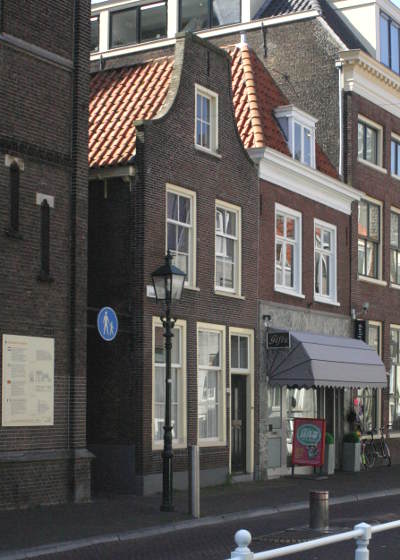
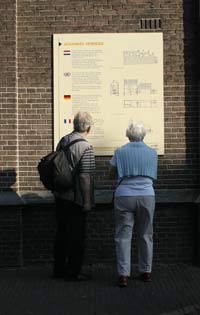
On the west corner once stood a house called Trapmolen, (today’s Oude Langendijk 25) (fig. 1) on the east, a particularly large house once referred to as Serpent, which was eventually demolished in the eighteenth and early nineteenth centuries, replaced by the neo-Gothic Maria van Jessekerk that stretches along the whole east side of the today's Jozefstraat. A commemorative plaque (fig. 2), an initiative of the Dutch art historian and Vermeer/Delft expert Kees Kaldenbach, signals the place for today's curious.On June 20, 2003 the official Dutch Traffic Board ANWB placed at the Delft canal location Oude Langendijk a large panel containing various images of the house which once stood right there. For several decades, art history literature, influenced by Van Peer, consistently asserted that Vermeer’s family lived in Maria Thins's house,Serpent was presumed to be owned by Maria Thins, Vermeer's supportive mother-in-law. However, the actual owner proves Pieter van der Dussen. Trapmolen was owned by Machteld van Beest (aka "widow van Nerven") who owned other properties in Delft, including no fewer than four neighboring houses on the Oude Langendijk, and lived in the Swanenburg house, a larger building with greater status, located three houses west of Trapmolen. (Kindly uggested by Hans Slager via personal communication.)
The Kaart Figuratief (fig. 3), an illustrated map representing a bird’s-eye view of the city the city from 1675–1678, allows us to visualize the precises location and relative dimensions of Serpent (fig. 3; C) with its long blank side facade, and wall anchors on the Molenpoort side. This building was notably large for the area, with an extended structure and seven fireplaces, suggesting its previous use as a malt house and inn. With its long main building, the structure was above average in size in comparison with the surrounding properties. The entire complex must have been thirty m deep, exceptional dimensions for a house.
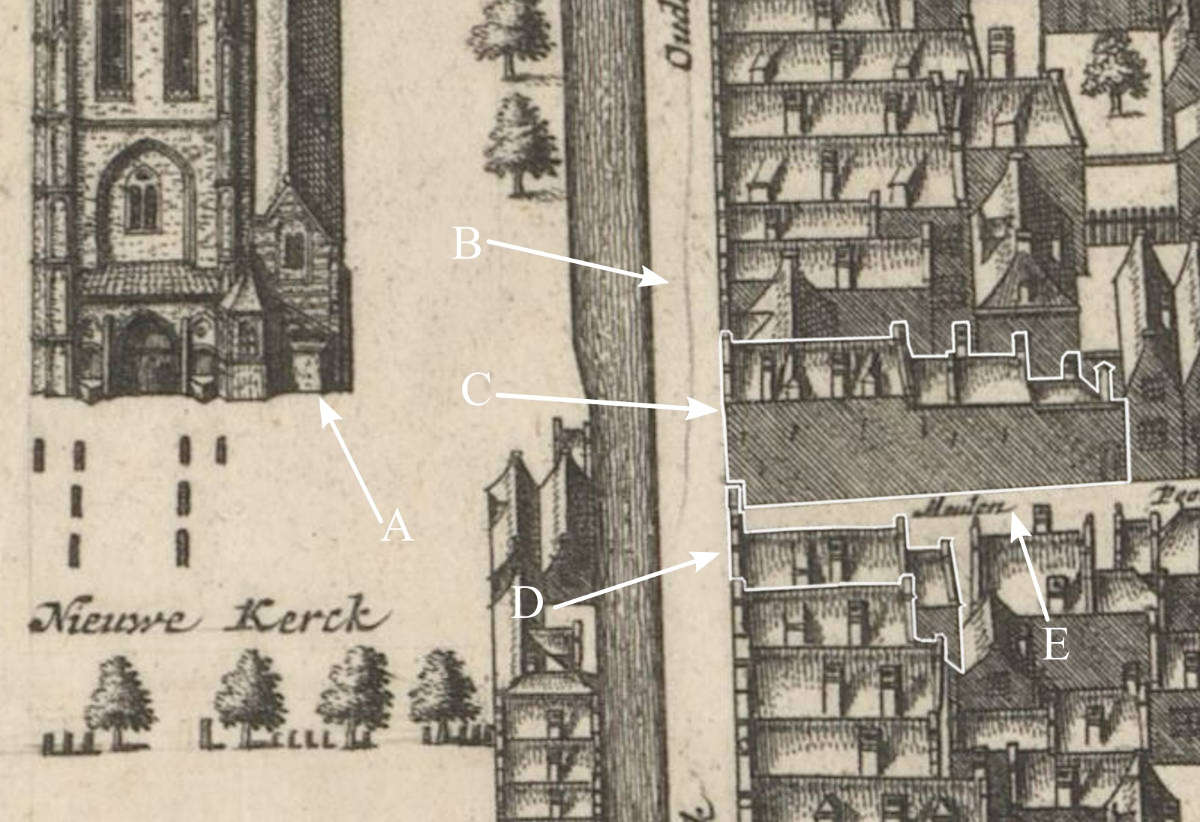
A. Nieuwe Kerk
B. Oude Langendijck;
C. Serpent house
D. Trampolen house
E. Molenpoort
The belief that Vermeer lived in the Serpent stemmed from Van Peer’s mistaken assertation that identified the house as owned by a certain Jan Tin, later corrected to Jan Geensz Thins by Montias, who believed that Maria Thins and her family rented this house from the Jesuit fathers and allowed Catharina and Johannes to move in after 1653.John Michael Montias. "Chronicle of a Delft Family," in Vermeer, edited by Albert Blankert, Gilles Aillaud, and John Michael Montias, (Woodstock and New York: Overlook Duckworth, 2007), 45. This hypothesis was widely accepted in Vermeer literature for fifty years. Montias maintained that the Thins house is pictured in an eighteenth-century drawing (fig. 4) of Jesuit church on Oude Langendijk by Abraham Rademaker (1677–1735), an eighteenth-century painter and printmaker from the Northern Netherlands, as furthest house immediately to the right, or the house outside the drawing to the right.
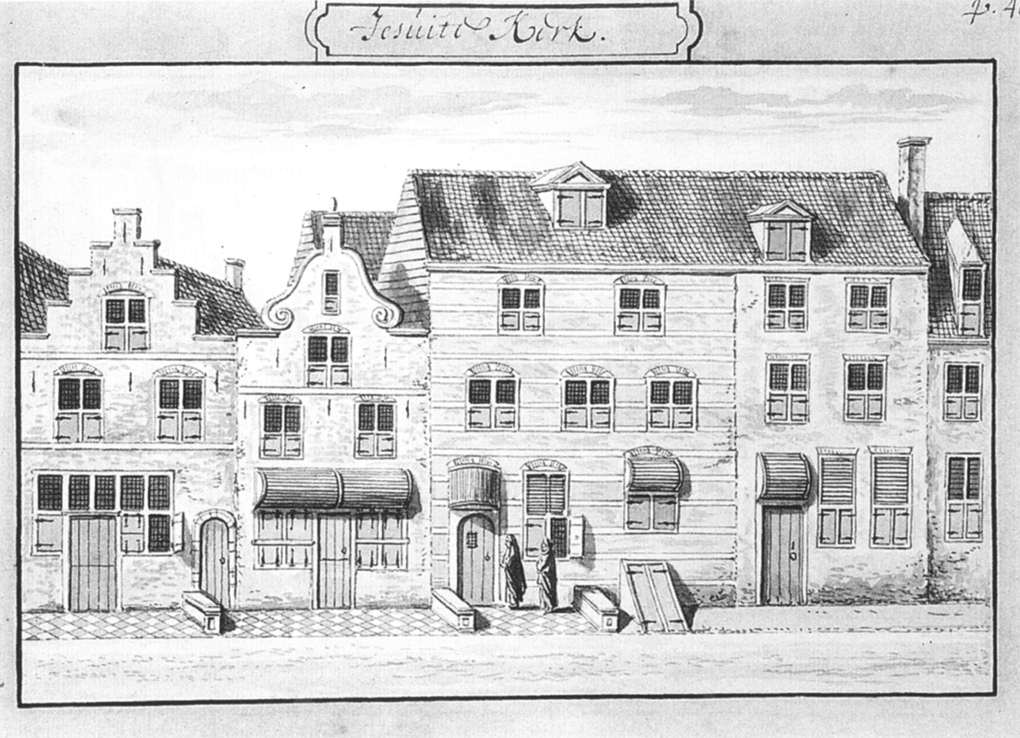
Abraham Rademaker
c. 1670
Brush and gray ink, 13.2 x 20.2 cm.
Gemeentearchief, Delft
But Slager, who focused only on archival data and details, provided a detailed rescontruction of the Oude Langendijk and Burgwal areas. He demonstrates that the Thins family owned neither of the corner houses of Molenpoort. There is, he shows, unsurprisngly, no deed of purchase; nor has any lease agreement survived. The illegality and seclusion of the Catholic community would have meant that many transactions were arranged privately among neighborhood residents, without the involvement of an official, usually Protestant party, such as a notary, lawyer or orphan chamber, so that little or no information has survived in the Delft archives. Slager’s thorough archival research involved an in-depth reanalysis of old data, adding new information that Vermeer actually resided in the smaller Trapmolen house on the west corner.Earlier deeds record the house had a rosmolen (horse driven mill) that likely lay behind it.
Slager discovered that in 1641, Jan Geensz Thins had actually purchased a different building than either the Serpent or the Trampolen, which was not the corner building. Additionally, 1667 municipal records for the corner building reveal that the "quay tax.In the 17th century Netherlands, a "quay tax" was a type of levy or tax imposed on properties located adjacent to a canal or waterway. The term "quay" (Dutch: “kade”) refers to either the street next to the waterway, or a platform lying alongside or projecting into water for loading and unloading ships. In Dutch cities like Amsterdam or Delft, which were characterized by their extensive canal networks, properties lining these canals were often subject to this tax. The quay tax could be based on several factors, including the length of the property's frontage along the canal, its size, or its use. The rationale behind this tax was likely twofold: firstly, properties on the canal benefited from their prime location, offering easy access for trade and transportation, and secondly, maintaining the canals and adjacent areas (like quays and bridges) was costly, and these taxes helped fund their upkeep. (Kindly uggested by Hans Slager via personal communication.) was paid not by Geensz Thins or Maria Thins, but by owner Pieter van der Dussen, scion of a wealthy Delft Catholic family, who had bought the Serpent house before 1656.5 This invalidates the most important argument in favor of the house on the east corner as Vermeer’s home.
Slager's research reveals that while the Serpent has a width of a little over seven meters, the Trapmolen (fig. 3; D) was nearly four and a half meters wide. According to the oldest Delft cadastral map, from 1823, the plot was about seventeen metres long. With room for a small courtyard, as indicated in the 1676 inventory, this leaves a length of about thirteen meters for the house, which is less than half the length of the Serpent, but still sizable for a residential house. The difference in size between the Serpent and the Trapmolen across the alley is clearly visible on the Kaart Figuratief. The map shows a front house with a small rear house, behind which lies a small courtyard that opens onto the Molenpoort. Prominent features include the two chimneys on the main building, the windows and the billboard on the Molenpoort and the position of the front door – today all the way to the right of the facade – which in keeping with seventeenth-century usage is still located in the center.Serpent was legally owned by Pieter van der Dussen but in practice, like Trapmolen and other houses in the Papist corner, was bought for the Jesuit mission to use and rent out. The earliest image of the Trapmolen, giving a clear picture of the building, dates back to 1858 and was produced by Leiden lithographer and draughtsman Christiaan Bos.
According to Slager, the rooms and household effects recorded in Vermeer’s 1676 probate inventory fit comfortably in the present corner building.H.G. Slager, "Vermeer’s House Revisited" (Ommen, 2018), online paper, Essential Vermeer. The successive quarters also match the inventory drawn up following the death of a cloth merchant, who died in the house in autumn 1801. While the house now has an eighteenth-century facade and the side facade along the alley shows later brickwork and newer windows, its shape and ground plan still provide a good picture of the situation when Vermeer lived here.Both Ab Warffemius and Henk Zantkuijl have also made attempts in the past to draw the layout of the house in 3-D based on Vermeer's inventory after his death- Kee Kaldenback, instead attemtped the same taks with Trapmolen.. See: Kees Kaldenbach, with contributions by Allan Kuiper and Henk J. Zantkuijl, "Working towards a Reconstruction of Johannes Vermeer's Home at the Oude Langendijk, Delft," accessed December 28, 2023, https://kalden.home.xs4all.nl/vermeer-info/house/h-a-reconstructie-ENG.htm.
Thus far, none of those who sustain the Serpent location have addressed Slager's claims.
click on the thumbnails below to access high-resolution images of the Oude Langendijk, Delft, and two pages of the inventory
GEMEENTEARCHIEF DELFT - records of J. van Veen, no. 2224
Catharina Bolnes
Maria Thins and Catharina Bolnes
Specification of all the household and movable goods that Catharina Bolnes, widow of the late Sr. Joannes Vermeer, living on the Oude Langendijck, at the corner of the Molepoort, has coming to her in possession, [which goods] are deposited in the aforementioned housing.
Specification of all such household goods and furniture ("inboel") as Juffr. Maria Thins, widow of the late Reynier Bolnes, and her daughter Juffr. Catharina Bolnes, widow of Joannes Vermeer, each to the true extent of one-half, having coming to them, [which goods] are deposited in the house of the aforenamed widow on the Oude Langendijck on the corner of the Molenpoort.
In the front hall ("voorhuys")
- a fruit painting
- a small seascape
- a landscape
- a painting by Fabritius
- a cabinet of joinery work
- a large painting of Mars and Apollo in a bad black frame
- 2 paintings somewhat smaller
- four more paintings with bad frames
- a mirror with an ebony frame
- a wooden footbench
- four bad green chairs
- two bad tapestry-covered cushions
In the great hall ("groote zael")
- a painting representing a peasant barn
- another painting
- two paintings, "tronien" (faces) by Fabritius
- one wherein three gourds and other fruit
- two portraits of Sr. Vermeer's late father and mother
- three small drawings in front of the mantlepiece with black frames
- a drawn coat-of-arms of the aforenamed Sr. Vermeer with a black frame
- a pair of green silk curtains with a valance in front of the bedstead
- a mantlepiece covering of the same material
- a striped curtain
- an iron armor with a helmet
- a pike
- a lead hat fringe[?] ("lode hoede rand")
- linen and wool
- a Turkish mantle of the aforesaid late Sr. Vermeer
- a ditto "innocente" [loose robe worn by men]
- a [pair of] Turkish trouser[s]
- a white satin coat
- a ditto yellow
- a white satin bodice
- a yellow satin mantle with white fur trimming
- an old green mantle with white fur trimmings
- Juffr. Vermeer's ash-gray travel mantle
- a black Turkish mantle
- a black cloth gown ("tabbert")
- a black cloth robe
- twelve bedsheets, good, and bad
- twenty-two ditto pillowcases ("sloopen"), large and small
- five damask[?] ("kruysserviet") tablecloths
- nine napkins
- twenty-one children's shirts so good as bad
- two women's shirts
- 28 bonnets
- 11 children's small collars
- 17 back pocket handkerchiefs
- two Indian coats ("labaertjens")
- seven pairs of muffs ("moutgens")
- three white caps
- three children's aprons
- two night shirts
- ten men's ruffs
- thirteen pairs of fancy cuffs ("ponietten")
- a cabinet of joinery work with inlaid ebony
- a whitewood pull-out table
- a little oak chest
- nine red-leather Spanish chairs
- three green sit-cushions
- a green tablecloth
- an ebony wood crucifix
- ten portraits of the lineage of the aforenamed Juffr. Tins all with bad black
- frames
- a painting representing the Mother of Christ in an oak frame
- one more painting of the Three Kings
In the small room adjoining the great hall
- a great wooden painted coffer with iron fittings
- a bad bed ("ledicant") with a green cover on it
- a round table tray ("tafelblad")
- a fire screen ("viermande")
- a little rack
- a great high tole ("blick")
- a tole bedpan ("confoortje")
- two copper snuffers
- an iron candleholder
- seven glass flasks
- three roemers
- twelve earthenware plates
- and other earthenware of little importance
- an oak table
- a child's bed with a head pillow
- an ear cushion
- a green lined coverlet
- two paintings
- a red-painted board of a chest
- a pair of bad green curtains
- a ditto mantelpiece coverlet
- two old tapestry-covered sit-cushions
- a bad mirror
- two metal-ringed [child's] chairs ("beugelstoelen")
- two small secret coffers
- five earthenware shell-shaped dishes
- five other pieces of earthenware
- three Cologne butter dishes eleven earthenware jugs with pewter lids
- a copper mortar with a pestle
- a copper candlestick
- a copper bedpan
- a tin butterpot
- a tin ladle with a wooden handle
In the interior kitchen
- a large painting representing Christ on the Cross
- two "tronie" paintings done by Hoogstraten
- a painting wherein all sorts of women's stuff ("vrouwentuych")
- one of Veronica [Christ's face]
- two "tronien" painted in Turkish fashion
- a little seascape
- a painting hanging in front of the mantelpiece
- a (painting) wherein has been painted a bass viol with a skull
- a pair of striped curtains
- a little sideboard
- two brown foot warmers ("stoven")
- about seven ells of gold-tooled leather on the wall
- a bed with a head pillow three ear cushions
- two blankets, one green with one white
- a bedcover
- an oak chest
- a coat rack
- three chairs
- three green sit-cushions
- a striped cloth
In the little back kitchen
- an iron grill
- a pewter salad colander
- a vessel hamper ("een vate ben")
- an old lantern
- a chest to store peat
- a shelf for cans and jugs ("kannebort")
- an iron spit with its accessories
- a wooden spit
- a copper pan to bake small pancakes ("broederspanne")
- a copper bedpan
- a copper kettle
- two copper pots
- a copper milkpan
- four iron pots
- an iron flat-iron
In the cooking kitchen ("koockeucken")
- a bed with a head pillow
- two ear cushion
- two blankets, one green with one white
- a bed cover
- a rug cover
- a red-painted little table
- a coat rack
- a child's chair
- a striped mantelpiece coverlet
- six old chairs
- an old beer jug
- a pair of striped curtains with a valance
- a cupboard
- a wooden rack
- three blue sit-cushions with fringes
- four tin porringers ("eetkommitgens")
- two pewter dishes
- four pewter beer mugs
- an iron band
- a tongue
- a shovel for ashes
- a pewter flat candlestick
- 21 shell-shaped dishes
In the washing kitchen ("waskeukentgen")
- two spinning wheels
- a cradle
In the corridor
- two racks on which to dry linen
- a wicker basket
- a wooden sitting bench ("scharrebort")
Over in the basement room ("keldercamer")
- a bed with a head pillow
- two ear pillows
- two blankets, one green with one white
- a bed cover
- a painting of Christ on the Cross
- a painting representing a woman wearing a necklace
- three bad chairs
- a wooden trestle
- six tapestry-covered chairs
- a painting with a gilded frame
- one [painting] with an oakwood frame
- a little mirror
In the place ("plaets")
- a tin waterpot
- 10 tin spoons
- three pewter waterpots
- a copper kettle
In the little hanging room
- a red-painted chest
Above in the back room
- two rug covers
- a wicker basket wherein the mother sits and holds her child warm
- ("bakermath")
- a "tronie" painting
- a cupid (painting)
- two chairs
- two copper bedpans ("confoorten")
- five books in folio
- 25 other (books) of all kinds
- two earthenware dishes
In the front room
- two Spanish chairs
- a cane with an ivory knob on it
- two painter's easels
- three palettes
- six panels
- ten painter's canvases
- three bundles with all sorts of prints
- a desk ("lessenaar")
- here and there some rummage not worthy of being itemized separately
The above-standing goods were recorded by me, notary, admitted by the Court of Holland, at the behest of the aforementioned widow, who declared having acted in good faith, and if anything were to occur to her that she had forgotten, she will supply this amplification at any time. In token whereof, signed by her. Delft, the last day of February 1676.
Catharina Bolnes
Thus, recorded by me, undersigned notary, at the behest of the abovementioned…[left blank), who declared having acted in good faith, without having held back (to her knowledge) anything, and signed by her in due form in Delft on the last day of February 1676
Catharina Bolnes
For those interested in examining the contents of the inventory in further detail, please consult Kees Kaldenbach's exhaustive website study.


